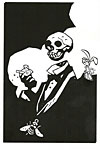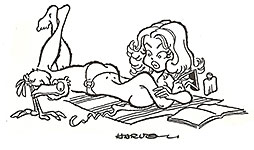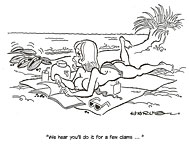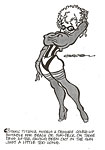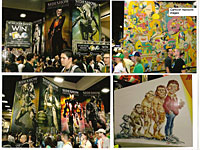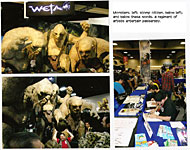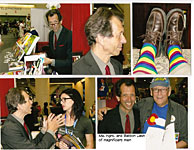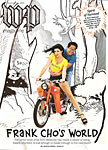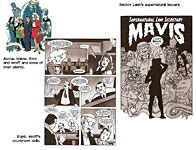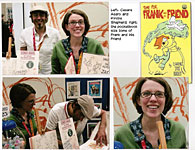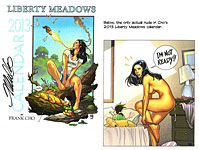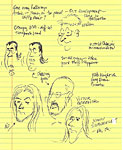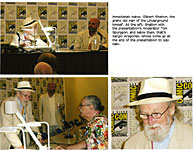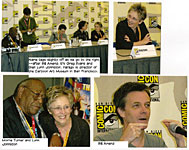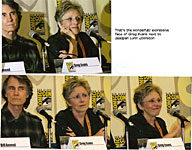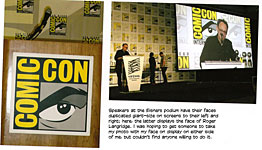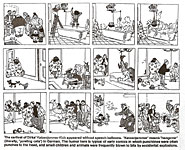 |
|||||||||||||||||||||||||
Opus 282 (August 25, 2011). By now, a month after the fact, you’ve doubtless heard all you care to hear about the Sandy Eggo Comiic-Con (July 21-14), whether you attended or not. So even though our chief focus this time is the Con, we won’t go into exhaustive detail, trying to report on every facet of the affair. Instead, we’ll skim through the weekend, briefly noting the Con’s immensity and the variety of entertainment media on display before regaling the Known World with an anecdote about academics and comics and sexism all over. We also report some of the news that broke during the Con and rejoice in comics fandom’s fiftieth anniversary. We
spent most of our time at the Con wandering the exhibit hall and picking up
splendid sketchbooks (mostly by animators) and other arty tokens—including Mike
Mignola’s hauntingly stunning calling card, which we display hereabouts with
Cahoots reminding us that it’s still the Year of the Rabbit. Herein, we also offer, in its entirety, Robert Crumb’s explanation for why he didn’t go to Australia as planned, and we issue what we hope is the final report on the foolishness at Renton, Washington and review The Essential Dykes to Watch Out For. And more, much more—as usual; here’s what’s here, by department, in order:
SANDY EGGO COMIC-CON Critical Approaches to Comics (and Sexism) Cultural Status of the Con Sandy Eggo News Flashes A Few Sessions Reported On Fandom Anniversary
NOUS R US Crumb Crumbles: Stays Home from Australia Correction and Postponement Renton, Washington: Part Two Nancy Silberkleit, Penis-Pointer, at the Con
EDITOONERY The Republicans Running for President The Borowitz Report on the Iowa Straw Vote
Comics Journalism Described
BOOK REVIEW The Essential Dykes to Watch Out For
Our Motto: It takes all kinds. Live and let live. Wear glasses if you need ’em.
And our customary reminder: don’t forget to activate the “Bathroom Button” by clicking on the “print friendly version” so you can print off a copy of just this installment for reading later, at your leisure while enthroned. Without further adieu, then, here we go—
SANDY EGGO The Leviathan Some More Again The convention center in San Diego is a gigantic steel and concrete sea shell washed up on the shore. It sprawls like a beached whale along the edge of the bay, bristling with the elbows of would-be flying buttresses, the ribs of a gigantic wrecked and rolled over sea-going behemoth like the sixteenth century Spanish galleon but much much larger. Climbing through the wreckage for four days in July (21-24th) were all the comic book fans and popular culture geeks that the law allows—125,000 of them bump up against the fire marshal’s limit, but probably there were another 20,000 more if anyone would (or could) do an actual count. Attendees became a glutenous mob as they milled around and eddied through the aisles of seven adjoining exhibit halls in which were monumental displays for LucasFilm, Lionsgate, Warner Bros, Hasbro, Mattel, Lego, Viz, Nickelodeon, Konami, Phineas and Ferb, Square Enix, Pokemon, Sideshow Collectibles—oh, and Marvel, DC Comics, Dark Horse, Image, and Diamond Distributors. Various special interest exhibit booths were clustered together—illustrators, urban vinyl toys, web comics, small press—and, oh, “gold and silver age” comic books. It would be a mistake to say the Comic Con International San Diego (to use its official name) is a comic book convention, but it’s preferred designation as a “popular culture convention” isn’t quite right either: it’s too broad. The Sandy Eggo Con (as if it is affectionately known here at the Rants & Raves Intergalactic Wurlitzer) is perhaps more accurately described as a “comic book culture” convention: it embraces that part of popular culture that grew out of or is closely allied with comic books—movies and tv series based upon comic book characters (or that could be based upon comic book characters—like Indiana Jones, f’instance), electronic games embodying comic book titles, toys depicting comic book characters, artists who illustrate so luxuriously the covers of comic books, movie posters, and game boxes; and on and on into the night. Or maybe, to resort to the argot of the day, it’s just a monster geekfest. Those who weren’t migrating from one exhibit to another in the mammoth cavern on the street level of the building were striding mightily through the vast reaches of the second floor hallways to reach one or another of the seventeen presentations offered simultaneously throughout the day. On Friday morning, I was striding mightily through one of those hallways to get from the National Cartoonists Society’s booth (where I occasionally rested during the day) in Hall B of the exhibit hall to meeting room 26AB on the second floor at the opposite end of the Center, approximately eight city blocks away. At 10:30 that morning, the Comic Arts Conference was sponsoring a panel presentation on “Critical Approaches to Comics: An Introduction to Theories and Methods.” The panelists were all contributors to a book with approximately the same name, master-minded and edited by Randy Duncan and Matthew J. Smith, college professors at Henderson State University and Wittenberg University respectively. Duncan launched the Comic Arts Conference in 1992 with Peter M. Coogan, who was then working his way through a graduate program at Michigan State University and is now at Washington University, having published his magnum opus, Superhero: The Secret Origin of a Genre. The original motive underlying the Conference was to bring together for their mutual benefit academics and practitioners—professors and cartoonists—to discuss the medium that both fascinated and engaged them. I was present at the first of these when Will Eisner and Scott McCloud and Steve Bissette were among those who attended and held forth. But these professionals made no presentations: they attended and commented, applauding mostly such presentations as that made by Leonard Rifas, who attempted to reinstate Fredric Wertham’s reputation as a psychiatrist—a not inconsiderable task, considering the hash Wertham made of scientific principles in his notorious diatribe, Seduction of the Innocent. Over the years, the Conference has expanded its offerings; lately, Conference-generated sessions appear on the program all day long for all four days. While practitioners have been featured in various of the Conference-sponsored sessions, mostly, if I am to judge from the session titles, the Conference has served chiefly as a place for academics to read papers about comics. And this morning’s session would be no different. The book, which is due out in a month or so, employs an unusual if pedagogically sound device: each of the contributors begins his/her essay by stating the theoretical principle that guided his/her delvings into comics and then delves for the rest of the chapter in a way that illustrates how the theory should be applied. I had been invited to contribute, and I planned to recycle my review of Alison Bechdel’s Fun Home (Opus 197) or Craig Thompson’s Blankets (Opus 123), but when the publisher came along later with a form I was supposed to sign, giving away all rights to my own work, I demurred: academics apparently agree to such terms because their continued livelihoods are assured by the number of publications they can add to their vitae, but I, who gain nothing by giving away my work, declined. But I wanted to get an idea of the book’s content, so I went to the session. David A. Berona (Plymouth State University), Andrei Molotin (Indiana University), Stanford Carpenter (School of the Art Institute of Chicago), Jennifer K. Stuller (ink stainedamazon.com), Henry Jenkins (University of Southern California) and Coogan rattled off their premises in good order, explaining methodologies that can be used to analyze meanings in comics and comics culture. And then they invited questions. I squirmed. Among the images that accompanied the presentations were some that showed Spider-Man cavorting through the air over New York City, resplendent in his skin-tight spidey regalia, and, from Jennifer Stuller, comic book panels that illustrated her premise that the comics were sexist because of the way women were depicted—typically in scanty or skin-tight attire that emphasized healthy protrusions for breasts and lustily rounded mounds for buttocks. As you can readily imagine, it was more than I could sit still for. And so I didn’t sit still: I arose and delivered myself of a harangue along these lines: “I don’t exactly want to ask a question, Jennifer. Instead, I’d like you to come with me on a short safari of exploration and, if we’re lucky, discovery. We start out at a familiar domestic crisis—one that has been going on for as long as there’ve been toilets—when, at the very onset of every marriage, the wife insists that her husband put the lid down. Every wife launches into wedded bliss with this demand. Oddly, no husband that I ever heard of has ever complained to his helpmate that she never leaves the lid up. No, and thus the fundamental inequity that distinguishes the relations between the sexes is re-established with every nuptial bond, and the same injustice is perpetuated throughout society at large in all its cultural venues. And so it is that men are forever reconstituted as the compliant gender. And because we are the compliant gender, we never complain that the charges of sexism in comics always conveniently neglect to mention the emasculation represented in the visual ravages committed on male anatomy.” I referred, then, to the pictures we’d seen of Spidey flinging himself around the New York skyline. In many of these images—particularly those full-frontal poses with legs akimbo—it is obvious that something is missing. Spidey is not equipped with the usual male package. He has no genitalia. He has been completely, and thoroughly—and literally—emasculated. The artists who draw Spider-Man and all other superheroes dutifully obey the laws that govern comic book illustration and deliberately eschew making pictures that hint at male genitalia. But not without unintended consequences, I said. “As Freud established long ago,” I continued, “a repressed impulse always seeks a way to express itself—as water will always seek a downhill path. Prohibited from depicting that part of the male anatomy that Anthony Weiner has lately brought into prominence, artists unconsciously seek respite from repression by drawing boobs and buttocks on female characters. They exaggerate these obvious attributes of the sex, focusing on them. The explanation for this preoccupation is simple: hooters subconsciously substitute for weiners. And so what you see, Jennifer, as sexism of a supposedly anti-feminist persuasion is actually a perverse manifestation of the male’s unconscious aspiration to equality between the sexes.” Jennifer responded. She tried to explain. But I suspect she missed what I intended as satire. I shouldn’t have done it, I realize. It was a cruel if not also crude joke. Do I really believe that drawing boobs and buttocks acts unconsciously as a rebellious attempt to assuage internal tension brought on by obeying the commandment to emasculate superheroes? No. But it sounds fairly convincing, cloaked, as it is, in the contextual robes of academic theoretical language. And in the context of often far-fetched theories, my analysis even makes a sort of rough sense. Perhaps, even, as Bernard Shaw has claimed, “every jest is an earnest in the womb of time.” In perpetrating my jest, I seem to be ridiculing academics and their seriousness of purpose. And, of course, I am—the deadly seriousness but not the purpose. In fact, I was motivated by mixed emotions. Comics have enjoyed nearly overwhelming academic attention in recent years. Seriously purposed tomes have been coming forth regularly for over a decade—more with each passing year as “comics studies” achieve a kind of intellectual legitimacy in the ivied halls of academe. All the attention makes me a little uneasy. I keep thinking of Bernard Shaw’s adamant refusal to let any of his plays be published in American literature anthologies for use in classrooms. He thundered that American attempts to teach Shakespeare had ruined the Bard for generations of readers/audiences, and he didn’t want his plays to suffer the same vandalism. (And as long as he lived, none of his plays were included in literature textbooks.) By the same token, I don’t want enjoyment of comics to be destroyed by academic excesses in well-intentioned but often misguided attempts to enhance our appreciation of the medium. On the other hand, academic interest in motion pictures fostered the notion of film as an artform. Without the attention that the professorial legions lavished on studying movies, motion pictures might never have achieved status as art. In like manner, the academy’s embrace of comics has undeniably helped in raising the cultural status of the medium. I suspect, however, that a burgeoning fandom, beginning in the 1970s—demanding higher quality “European-like” reproduction in comics products—had an even larger role in the levitation. And once comics specialty shops staked out turf for the medium thereby defining a market, publishers took notice and began to produce works that appealed to that market. Still, interest manifest in the ivied halls of academe can’t hurt. Unless Shaw is right. Pinioned by the horns of this dilemma, I surrendered to temptation and committed my joke. As I said, I probably shouldn’t have done it. (Then again, I’m probably attaching more importance to my foray into satire than anyone there did.) (I may even be seeing satire where no one else did. It wouldn’t be the first time that I’ve been subtle to the point of vague.) Jennifer Stuller seemed a knowledgeable and pleasant person and certainly didn’t deserve my tongue-in-cheek tirade. Or maybe— Maybe the perennial attacks on comics as conveyances of sexist attitudes warrant a little healthy ridicule. The charge of sexism in comics has been around for at least a generation. And I’m pretty sure that in all that time it has had little effect on the way superheroines and other female characters are drawn. The sexist charge turns on the issue of sex objectification: to portray women as sex objects turns them into sexual playthings, leaving individual personality out altogether. But the sex object gambit is simply rhetoric: in the early years of the feminist crusade, the function of the rhetoric was to draw attention to the gender inequality fostered by our culture. I had a woman friend whose last name was Goodman, and she seriously contemplated changing her last name to “Goodperson.” She didn’t, but if she had, she would have been deploying a rhetorical device to emphasize the extent to which maleness dominated Western culture. And the dominance of maleness effectively undermined any consideration of women as individual personalities. Useful as such rhetoric may have been at the beginning, it long ago became a threadbare ploy. Everyone realizes—and even admits—that humanity falls into two sexes and that each is attractive to its opposite as a means of guaranteeing propagation of the species. Fashions in wardrobe emphasize those aspects of one gender’s physical appeal to the other. I naturally observe women’s fashions more than men’s, and everything about women’s fashions—not haute couture, but the design of everyday wardrobe—is intended to enhance the female’s appeal to the male. In short, sex appeal. I observed some years ago that cleavage had returned; and breasts that bounce when their owner walks is likewise a fashion statement about sex appeal. And that is the way it should be. What shouldn’t be as a result is gender inequality in social or political or occupational realms. But surely we’ve progressed beyond sex object allegations as the means by which the inequality can be noticed and, perforce, remedied. To the extent that there are other worthwhile things in life than sex, so should women (and men) be seen as something more than sex objects. And that requires a cultural maturity that goes beyond mere rhetoric. Stuller (calling her “Jennifer” is clearly sexism of a demeaning sort) is charging into battle against sexism with out-dated weapons. In short, some things deserve to be laughed at as a way of moving beyond them. So maybe my joke wasn’t in such bad taste as all that. In the meantime, as we muster forces with newer weapons, we can still pause to celebrate the eternal feminine, which I do here. We don’t want the summer to fade away forever without a swimsuit issue; herewith—:
Cultural Status of the Con BY NOW, ANYONE IN AMERICA with pretensions to awareness of the machinations of popular culture knows that the Sandy Eggo Con is Comic Book Culture Triumphant. Entertainment Weekly cover-featured the Con the week before the event and the week after. The July 22 issue had the new Spider-Man on the cover (as you’ll see in a trice) “plus Comic-Con preview.” Inside, preview stuff. This happened in previous years, too, but this year, the hoopla spread to the funnies sections of the nation’s newspapers, too. Greg Evans sent a couple of his Luann characters off to the Con in ludicrous clothes; Keith Knight took himself to the Con in his autobiographical strip, Knight Life; Patrick McDonnell spent a week of Mutts with a double entendre series about “cons” that were “comic”; and Mark Tatulli did a Lio Comic-Con strip for Sunday, July 24, in which, as you’ll see in our second visual aid, he urged readers to come to the Con to meet him.
The Los Angeles Times, displaying that inexplicable right-hand’s-not-knowing-what-the-left-hand’s-doing behavior for which newspapers have lately become infamous, dropped the strip on that day, explaining to Tatulli that it didn’t want its comic strips to advertise — particularly, I assume, events in cities other than L.A. And yet, the L.A. Times’ “weekly entertainment guide,” Night & Day, offered its July 21-27 issue as “The Comic-Con Issue,”— “The Ultimate Insider’s Guide” to the Con. And followed it up with Hero Complex, another Comic-Con production, this one with the movie’s Captain America hulking on the cover. Hello? Anyone at work there? The Hollywood Reporter also produced a special Comic-Con issue with a great comic bookish cover by William Stout, and so did a raft of San Diego weekly newspapers. EW’s August 5 issue wrapped up coverage of the Con with a 14-page special section. Virtually every page reported on the comings and goings of tv and movie people—actors, directors, producers. I saw nothing about comics. “Going into the Comic-Con last week,” writes Jeff Jensen, “the buzz was that the annual pop culture Mardi Gras had lost its freaky fizz. ... And yet Comic-Con 2011 was the most jam-packed ever, remarkable for more aggressive, personal efforts to generate word of mouth” about forthcoming media ventures. ... Television shows dominated the confab this year—new shows and returning favorites. Video clips immediately jumped into cyberspace: “Comic-Con has become a made-for-cyberspace event, ideally suited to generating bits and bites of news and neat nonsense for a trending, streaming culture. Said Jon Favreau: ‘The big winner of Comic-Con 2011 was the fans. Hollywood worked harder to whip up dishes that could satisfy them.’” Comic book maker Todd McFarlane wasn’t quite so delirious. USA Today’s post-Con report said that for McFarlane, there is a downside to what he calls “Pop Culture-Con”: “You can live in obscurity here because these people are here to see Brad Pitt and whatever the trailers are. Only a fraction now is here for comic books.” Confirming McFarlane’s plaint: EW’s eight pages of photos of movie stars who attended the Con. Among the Tinseltown tidbits at the Con—a sneak peek at “The Adventures of Tintin” with Steven Spielberg making his first-ever Con appearance, in commemoration of which, no doubt, he received the Con’s Inkpot Award for lifetime achievement, saying: “I wouldn’t be here if it wasn’t for you. We’re all in the same world together.” He also announced that he’s hired a writer for a fourth “Jurassic Park.” And Andrew Garfield, the new Spider-Man, who showed up disguised as a fan in a cheap Spidey suit, was in unabashed gush as he appeared before a crowd: “I needed Spidey in my life when I was a kid. I owe the Webhead a lot. This is definitely the coolest moment of my life.” In the previous issue of EW, the one that came out during the week of the Con, Sandy Eggo is mentioned again during an interview with “Cowboys & Aliens” stars Harrison Ford and Daniel Craig. The interview was conducted by Benjamin Svetkey before the Con, and he refers to the movie’s premiering at the Con—“It’s the first time a major tentpole has had a world premiere there,” he asserts. Oddly, although the premiere was covered by USA Today, it wasn’t mentioned in either of the program booklets handed out to Con registrants. Or maybe I’m missing something. I saw skyscraper-high billboard advertising for the flick plastered up the Convention Center side of the Hilton hotel, but I didn’t hear any roars or snores about a screening of the movie. Maybe the screening was to be a big surprise and nobody came. Dunno. Svetkey reminded Ford and Craig that they had been at the Con last year while they were still making the movie. “Harrison, you were actually led in wearing handcuffs,” Svetkey said. “I was drugged and handcuffed, yes,” said Ford. Said Craig: “Because you asked to be drugged and handcuffed. You said you would go only if you were drugged and handcuffed.” “Not both at the same time,” reposited Ford. Asked what he thought of the Con, Ford said: It was very dark. The lights were on us and I couldn’t see what was out there.” Svetkey pursued the subject: “You didn’t see any families dressed like Wookiees or stormtroopers?” “I saw nothing,” said Ford. “But, you know, I’m delighted to go anyplace where I’m welcomed like that.” Despite all the excitement in the popular press, not everyone got the Word. Browsing in a t-shirt shop in Seaport Village, an outgrowth of boutiques and eateries along the marina’s waterfront near the Convention Center and its adjacent skyscraping hotels, I overheard a somewhat elderly (my age) woman customer talking to the clerk (also somewhat elderly) about the Con: “... and the place is full of a bunch of grown men,” she exclaimed in wonderment.
Sandy Eggo News Flashes SINCE I CAN’T HEAR WELL ENOUGH to enjoy the programmed presentations in the upper stories of the Center, I mostly wandered the aisles in the exhibit halls, gawking at the product on display. But other reports on the doings upstairs and elsewhere proliferated in the weeks after the Con, so I’m able to pick their brains and reports herewith. John Hogan at graphicnovelreporter.com apparently went to a lot of doom and gloom sessions at which the futures of the graphic novel and the comic book were pondered. But he, like most human [sic] sapiens, was unable to report anything definitive about the future. “Before the doors of Comic-Con even opened,” Hogan wrote, “Milton Griepp's incredibly informative annual ICv2 conference once again relayed the state of the industry to professionals. As will probably come as little surprise to anyone, the market is down, but there is some good news to be found within. In 2010, the comics market dropped 8%, and the graphic novel market dropped 5%. Overall, everything was down 7%. In the first half of 2011, comics were down the same, 8%, but graphic novels were up 3%. “There was an overall decline of 2%,” Hogan continued. “Much of the decline was attributed to drops in manga sales—a 15% drop in 2010 and a 10% drop in this first half of 2011 [with more of the same inevitable due to the demise of Borders—RCH]. This is always an interesting aspect, because sales drops in this category do not necessarily mean that fewer people are reading them. In fact, I would argue the opposite, with sales taking a hit but readership actually growing. For graphic novels, Scott Pilgrim and Walking Dead are the two biggest hits of the industry. “Interestingly,” he went on, “graphic novel sales were down 6% at comic book stores, but they were up 7% at bookstores. Kids and YA titles remain the biggest section, and Amazon continues to gain more market share. And while their overall market share is small, digital comics will double their sales this year. In the next two years, for example, 20% of U.S. households will have a tablet—so obviously the market for digital sales is growing. Still, though, comics are lagging behind the book industry when it comes to making the digital transition.” Hogan said there was a lot of talk about the digital future, ranging from how great it was to how evil it was. But no one could say what the future graphic novel might be. Ditto the comic book, which still seems doomed, saith the experts. “The big buzz word throughout the Con,” Hogan said, “is transmedia—how the world of comics will branch out into other media. A few years ago, that might have been called cross-platforming or something else. Basically, original intellectual property needs to be spread across multiple aspects of media, and it's happening more and more.” Overall, Hogan felt, it was “another amazing Comic-Con.” And then he had second thoughts: “Or was it? The question came up more than once about whether this Con was better, worse, or the same as in previous years. There's an air of doubt over how big the Con is and how removed the focus is from actual comic books. The point was driven home to me when I heard from several friends about the ordeal of trying to buy their tickets for next year—$175 for an event 12 months away that they worry about not being able to attend. It's a scary prospect for them, but for me it's more than a little annoying: they're not battling other comic book fans for the chance to attend. They're battling the new crowd. Is that better? Worse? It's definitely harder for the average fan, but unlike digital books, I don't think we have to wait to see what kind of impact is coming. It's already here, and that is not always great news for those who just love comic books—or those selling them.” By “the new crowd,” Hogan means the movie fans, I suspect. And it’s undeniable that Hollywood has shanghai’d the old Comic-Con, leaving only frayed remnants of its days of glory—a pitiful cluster of 60 booths designated “Gold and Silver Age ‘Pavilion.’” At other booths in other parts of the hall, cartoonists and publishers peddle their wares—comics and cartoon sketchbooks (delicious ones, many by moonlighting animators)—but compared to the massive presence of movie-makers and their ilk, comic books, particularly of Gold and Silver vintage, are conspicuous by the void where they used to be. And that’s not all that’s missing. “There’s no Golden Age panel at this year’s Con,” Mark Evanier told me when we crossed paths in the eddying exhibit hall crowd. “And there probably never will be a Golden Age panel again.” David Siegel, who, in the early days (and continuing through the years), was largely instrumental in ascertaining the whereabouts of Golden Age artists and writers, told me the same thing. “All those guys are gone,” he said with a grimace. They’re dead or are too ill to travel long distances. Evanier, who has moderated every Golden Age panel known to fandom, says even Silver Age panels are not likely anymore either. Most of the potential Silver Age panelists are either unable to make the trip or else don’t have anything to promote at the Con and therefore no reason to put in an appearance.
*****
CANNY PUBLISHERS often arrange to make this year’s earth-shaking announcements during the Con. Many such blockbusters were reported in Comic Shop News, No. 1260, so I don’t intend to repeat them all here. But I’ll make note, briefly, of those that most interest me. Marvel will be issuing a line of original graphic novels under the heading Season One. Produced by today’s creative teams, the books will dip into the past to reintroduce elements of the classic storylines for Marvel characters, updated for contemporary consumption, deploying more modern styles of art and storytelling, plus up-to-date technology and cultural allusions. Season One is not a reinvention of the iconic characters: “Everything you know about them, everything that’s existed for the last fifty years, still exists and is still there,” said Tom Brevort, Marvel’s senior vp and executive editor. “These are individually new stories, even though they’ve got bits and pieces of old and formative origin stuff in and around them as well.” The Fantastic Four, X-Men, Daredevil and Spider-Man will be the subjects of the initial quartet of books, the first of which is scheduled for release early in 2012. At Riverdale, Archie will meet KISS again. And in a second KISS event, IDW will produce new KISS comics. Adding to the excitement, Kevin Keller will become a part of the alternative-future series Life with Archie: The Married Life, and Kevin, too, will be married—to a same sex spouse. Dark Horse welcomes Tim Seeley back to do a four-issue series in the world of the mystical hero, the Occultist, drawn by Victor Drujiniu, who drew the first one-shot. The vampire novels of P.C. Cast and daughter Kristin Cast will appear in comic book form, but House of Night will not be adaptations of the original prose: it will consist of original stories by writer Kent Dallan and artist Joelle Jones. Said Mother Cast: “Watching my characters and their world come to life with the fabulous team at Dark Horse has been fulfilling and fun. Fans are gonna love these comics!” DC is bubbling over with Grant Morrison: he’ll be bringing back Batman Incorporated in the next few months, and he is also talking about a significant storyline in Action Comics that will reveal how Superman got his uniform and why he got it. Morrison rejects the notion that Clark Kent got his mom to sew him a costume. “Morrison revealed that Superman’s cape will be the blanket he was wrapped in as a child.” This tidbit, CSN divulges, led Morrison to compare Superman’s cape to Linus’s blanket in Peanuts. But I’m reminded more of Jason Ciaramella’s The Cape (reviewed last time, Opus 281). Dan Didio confirmed that the DCU multiverse still exists after the New 52 relaunch, and Grant Morrison’s Multiversity will explore that multiverse in a major way (perhaps involving the New Gods). DiDio also said DC has plans for Shazam! and the Marvel Family. And Lady Luck, a Golden Age creation of Will Eisner, will show up in the Justice League. Under the Vertigo label, Bill Willingham will be writing the initial story arc in a new spinoff from Fables. Called Fairest, this series will feature Sleeping Beauty, Cinderella, and Rapunzel. Fantagraphics continues to amass the rights for startling new publishing projects. Having launched the reprint of the Floyd Gottfredson Mickey Mouse newspaper strip, Fantagraphics’ next big project is reprinting the storied EC Comics, starting in 2012. But instead of reprinting titles in chronological order as Russ Cochran did, Fantagraphics will do books that focus on the work of individual artists. The first, Corpse on the Imjin & Other Stories, will collect Harvey Kurtzman’s war stories; the second, Came the Dawn & Other Stories, will collect Wally Wood suspense tales. Jack Davis and Al Williamson will be next. Four black-and-white EC collections will be released each year. IDW will issue a 13-part Frankenstein Alive by Steve Niles and Bernie Wrightson; they’ll pick up the story where Mary Shelley’s book leaves off. Said Niles: “The fact that I grew up worshipping Wrightson’s Frankenstein and now I’m working on a sequel with him is mind-blowing. This is the project of a lifetime for me.” IDW is also planning to launch a monthly Popeye comic book in the tradition of E.C. Segar. And the publisher’s Artist’s Editions will continue with Wally Wood’s EC Stories, Will Eisner’s The Spirit, and John Romita Sr.’s Spider-Man. Editor Scott Dunbier says every single page in each of these tomes will be shot from original art—which is why similar editions of work by, say, Neal Adams on the X-Men and Barry Windsor-Smith on Conan are almost impossible to assemble because the original art has been scattered among numerous collectors over the years. At Image, Frank Cho is doing Guns and Dinos, a series that Cho describes as “what ‘Jurassic Park’ should have been.” The series will regale us with stories about scientists trapped in the era of dinosaurs, trying to survive until they can find a way to get home. Cho is also working with Joe Keatinge on Brutal, the story of a female assassin who is, er, very very brutal. I
stopped by Cho’s table in an illustrators “pavilion,” and he told me he’s
hoping to direct a movie before too long. He also gave me a copy of last
summer’s Washington Post Magazine that pictured him on the cover, riding
behind a toothsome Brandy-like wench on a motorcycle. “Cho,” writes the Post’s Annys Shin, “has built a career drawing voluptuous women and catering to other men who share his stubbornly adolescent sense of humor.” Shin continues, describing Cho’s first book signing in Paris, where he is “doing something he excels at: drawing women’s breasts. This particular set is spilling out of a bikini top as the young man who requested the sketch looks on. But as the 20 or so other men behind him in line well know, Cho is capable of drawing almost any permutation: breasts in profile, breasts under t-shirts, breasts amplifying superhero logos, and so on. And they all have one thing in common: their disproportionate size. For Cho, 38, who grew up in Beltsville, the son of Korean immigrants, the alphabet starts with two letters, both of them D. “His clean fluid line and precisely rendered figures, both human and animal, also show off his considerable skills, which have earned him numerous awards, a nationally syndicated comic strip at age 23, and, for the past seven years, a steady gig as one of Marvel Comics’ best-selling illustrators. Now he can add to that lit a following on the other side of the Atlantic.” The article is an unusually complete and thorough biography for a magazine article: Shin visits Cho at the home of the artist’s parents, discusses his career and his failed marriage and his relationship with his two daughters, ages 6 and 8. “As divorces go, Cho’s has been amicable. She kept the house; he kept his artwork. And they have worked hard to make the transition as smooth as possible for their daughters. Cho still picks them up from school every day and drops them off at his old home. And twice a week, they come for dinner.” Cho’s rapid rise as a cartoonist and illustrator still amazes him. “I’ve just been stumbling up,” he said. But he wonders how long it will last—“how long before his style is no longer popular. ‘I’m at my peak,’ he says. ‘Maybe my star will fall.’” But I doubt it. Not as long as there are women and men.
*****
WHENEVER MY FEET started swelling up from overindulgent meandering through the exhibit hall, elbowed to and fro by the eddying mobs, I sat down for a few minutes at the National Cartoonists Society booth (where Greg Evans of Luann fame was a nearly constant presence), or I attended a program session upstairs. I couldn’t hear much at the latter, but I usually heard something. At the Spotlight session for Jodi Bernet, one of my favorite comic book artists, currently doing every other issue or so of Jonah Hex, Sergio Aragones joined Bernet at the head table. Bernet, a Spaniard, speaks little (if any) English, so Sergio was there to translate. (A stunningly unlikely role, as anyone who has heard Sergio mangle the English accent can attest.) Sergio would listen to questions from the audience, then turn to Bernet and translate them into Spanish; then listen to Bernet and turn back to the audience to translate Bernet’s replies. Caught up in this rhythm, Sergio once translated English into English: after listening to a question, he turned to Bernet and repeated the question in English instead of Spanish. Bernet nudged him back to reality, and Sergio smote himself mightily on the forehead. One never knows whether fun-loving Sergio does this kind of thing on purpose or not. Frank Stack was among this year’s Special Guests. As Foolbert Sturgeon, Stack was one of the legendary fomenters of underground comix: working on a post-graduate degree in art at the University of Wyoming in the fall of 1962, Stack sent one-page cartoons about the modern travails of Jesus back to Gilbert Shelton, a cartooning friend from Stack’s undergraduate days at the University of Texas (and another of the “founders” of comix), who subsequently (in early 1963) caused the Jesus cartoons to be photocopied in modest quantity and stapled together behind a title page proclaiming The Adventures of Jesus, often termed, with perfect hindsight, the “first comix book.” Stack enjoyed a life-long career as a professor of fine art at the University of Missouri, where he managed the art department gallery, served as chairman of the department for a time, and founded the Comics Collection at MU’s Ellis Library. He once told me that he believes he’s produced more watercolor paintings than any modern artist, and I, having seen a few thousand of them heaped around his home, believe him. Despite his devotion to watercolor and print-making, Stack continues with an almost equal passion to produce comics. His current project, a graphic novel entitled Kiss Me, Jesus! The Passion Story Told by Mary Magdalene, is to be released this summer, but only, so far, in French. We had dinner together one evening, and I’m happy to report that Stack is as peevish as ever about many aspects of modern life. We agree on virtually everything. Two peevish old coots. “Comic strips in newspapers no longer appeal to artists,” he pronounced, a pained and thoughtful expression slowly spreading across his whiskery visage as he chose his words, “—they don’t give you enough space to draw in.” As
for art in general, he anoints Peter Bruegel “the best artist: you can look at
him all your life and still not have seen everything in there.” The Special Guests at this year’s Con included mostly artists, but of those, only a couple newspaper cartoonists—Patrick McDonnell (Mutts) and Mel Lazarus (Momma, now in its 41st year of syndication). Lazarus has also written two novels: The Boss is Crazy, Too (1954), based somewhat upon his experiences working in Toby Press, a comic book publishing enterprise of the Capp brothers, and The Neighborhood Watch (1986). Lazarus was spotlighted at a session moderated by my NCS nemesis, Tom Gammill, a painfully funny man. A couple of times, I wandered across the street to the Tr!ckster pop-up store at the San Diego Wine and Culinary Center, where books by the participating artists were for sale and periodic seminars transpired. As reported at Opus 280, Tr!ckster is an invention of some Bay Area artists who wanted a place at the Con “that celebrated creating art instead of the Comic-Con’s shift towards consumerism and its many tentacles including Hollywood, fandom and cosplay.” It would be a “counter-Con festival” (see trickster.com). One evening, Tr!ckster was a party, cocktails, wine and beer and interaction among artists and their fans in the display room and out on the patio. The endeavor seemed a modest success; mayhap it’ll return next year—and in the meantime, pop up at other conventions. While finding my way to Tr!ckster, I chanced upon a parking lot that had been converted to South Park for the duration. Milling around people, eating lunch at picnic tables and having their photos taken with cut-out South Park characters. Dunno how this came about. Or why. But it seemed to belong somehow.
*****
EVERY SANDY EGGO CON is thoroughly themed with anniversary festivities. This year, more anniversaries than usual festooned the weekend: the 50th anniversaries of the Fantastic Four and of Spy vs. Spy, the 25th anniversaries of Dark Horse, SLG Publishing, and the Comic Book Legal Defense Fund, and the 20th anniversary of Jeff Smith’s Bone. And the birth 50 years ago of “comic fandom.” The official souvenir book devoted over 30 pages to the Marvelous creation (mostly drawings of the FF), but the second highest page count was fandom’s—15 self-congratulatory pages, heavily laden with illustrations that revived memories of long-departed fanzines. The Golden Jubilee determination for comics fandom is anchored in the debut dates of at least two fanzines, Jerry Bails’ Alter Ego in March 1961 and Don and Maggie Thompson’s Comic Art a few weeks later that year. The fanzine cover illustrations in this section are numerous—I can’t think of a fanzine not present pictorially (except for the conspicuous absence of The Buyers Guide, Alan Light’s weekly tabloid-adzine, and The Comic Reader; but both are of somewht later vintage than the 1960s, which is the focus here)—but the dates of the first issues are mostly missing. Too bad: it would be nice to have a complete and accurate historical document. Since most of the pictured covers are not of the inaugural issues, my guess is that the selection was based upon availability: whatever issue the editors could lay their hands on was used to illustrate each publication. A late Saturday evening party, heavily laden with hors d’oeuvres, celebrated several of the so-called “founders” of fandom: Jean Bails (widow of Jerry Bails), Richard Kyle, Paul Levitz, Dick and Pat Lupoff, Bill Schelly, Roy Thomas, and Maggie Thompson (widow of Don Thompson). The late Shel Dorf, who was somewhat grudgingly recognized as the “founder” of the Comic-Con after he died in 2009, was barely mentioned in the fandom history recited in the souvenir booklet: the founding of the Con is attributed to “a group of area fans, including the legendary Shel Dorf.” Including? I rigorously refudiate the implication that he was just one of the bunch: he was the leader of the bunch, and if you want to know more about Shel, re-visit Opus 251, wherein his entire life is rehearsed. But maybe I shouldn’t be so outraged: in the same slighting sentence, Shel is referred to as “an organizer of the Detroit Fair of 1965, along with Jerry Bails.” Which is true, but others were involved in the Detroit enterprise, too, and they aren’t mentioned: chief among them, Robert Brosch, who, with a couple of others, spawned the prototype in the spring of 1964. The others are named at Opus 251. Ah, well. This “history” isn’t really history: it’s a memoir in which the vagaries of fickle recollection are given precedence over the facts of actual events. Shel is scarcely the only fandom founder that history as well as memoir have neglected. Who remembers Brosch? And I suspect his memory of his role in comic fandom is tinged not a little by the bitterness fostered by the neglect. I phoned him one time, thinking to interview him about those formative years, and as soon as he heard me mention “comic convention,” he hung up on me. And who remembers Bernie Bubnis who organized the first New York comic convention and coined the term “comic-con”? So Shel is keeping good company: seems to me too many of the founders have become foundlings. Prolonging the neglect, Shel wasn’t mentioned in the little booklet handed out at the celebratory soiree. No sign of him anywhere among the canapes. He was, however, commemorated in a spectacular fashion at the San Diego airport, where a cartoon character mural was installed the length of the pedestrian bridge connecting Terminal One to its parking lot. Engineered by Matthew Lorentz (and perhaps others of Shel’s friends), the mural’s ostensible purpose (“The Sky’s the Limit”) is to memorialize aviation: the beginning on the left features a drawing of Charles Lindbergh, whose Spirit of St. Louis, the airplane he soloed across the Atlantic in, was built by Ryan Aircraft in San Diego; other airplanes and hovercraft float across the panorama until we get to Steve Canyon, the comic strip aviator whose speech balloons were lettered by Shel for several years, and then, at the far right end, just after a view of Snoopy taking off on his doghouse, an excellent caricature of Shel by Brad Constantine. The mural isn’t a permanent airport fixture: it’ll come down in the fall, making room for other artworks, no doubt. But for the time being—for the time of the Sandy Eggo Comic-Con—it was nice to see Shel Dorf hanging around his creation. And now, let me conclude with a crescendo of photos and pictures, starting with the airport mural and including an unconscionable number of pictures of your Faceful Reporter, as if you could ever forget what he looks like. No, really—I’m including all these autobiographical photos because I’m usually pictured with some notable personage, and I’m sure you’ll want to see what they look like (even the parrot).
AMAZING WORD GAME Did you know that, the words "race car" spelled backwards still spells"race car"? And that "eat" is the only word that, if you take the first letter and move it to the last, spells its own past tense, "ate"? And that “princes” is a word that changes from plural to singular and male to female with the addition of a single letter? And if you rearrange the letters in "Tea Party Republicans," and add just a few more letters, it spells: "Shut the fuck up you free-loading, progress-blocking, benefit-grabbing, resource-sucking, violent hypocrites, and deal with the fact that you nearly wrecked the country under Bush and that our president is black, so get over it." Isn't that interesting?
NOUS R US Some of All the News That Gives Us Fits
Crumb Crumbles Robert Crumb was scheduled to appear at the Opera House in Sydney, Australia, during the graphic arts festival there August 20-21. He was to take the stage “In Conversation” with Fantagraphics publisher Gary Groth, whose part in the conversation would be, chiefly, asking Crumb questions. But when Murdoch’s Sunday Telegraph took a look at some of Crumb’s big bootied broads and what Crumb’s comics did to them, it screamed in outrage—“Cult Genius or Filthy Weirdo”— and rolled out “professional pearl-clutcher Hetty Johnston,” a campaigner on behalf of victims of sexual assault, who objected to the “depraved thought processes of this very warped human being. These cartoons are not funny or artistic,” she ranted on, “they are just crude and perverted images emanating from what is clearly a sick mind.” Then a spokesperson for the federal Attorney General’s department said Crumb’s work could probably not be shown in Australia unless the cartoonist submitted his drawings for classification—and, most probably, they would be refused classification. Some sort of bureaucratic moral green card, I assume. On August 9, Andrew Tijs at The Enthusiast chimed in: “Anxiety and neurosis are hallmarks of Crumb’s work, but we in Australia know Hetty Johnston is nothing more than a headline grabber and toothlesss crank, wheeled out when writers want to inch closer to the front page of tabloids by using ‘shock,’ ‘outrage’ or ‘sick’ in a three-word 72-point screamer headline.” But by August 13, Crumb had endured enough of a continuing bombardment of outraged Aussie sensibility. In an open letter posted at the Sydney Morning Herald website, he explained what forced him to cancel his trip:
WEEKS AGO, I WAS INTERVIEWED by a journalist named Charles Purcell for The Sydney Morning Herald concerning my coming appearance at the Graphic festival. I was pretty open with Purcell over the telephone from my home in France, as I usually am with journalists. I'm not very clever at contriving a media image. I just bare my soul in my compulsive, confessional way. So, we talked a lot about sex, about my sexual proclivities, and Purcell played up this angle in his article of July 30. There are some very frank quotes in the interview. ''I'm a very eccentric oddball character, weird pervert'', and so forth. I'm also quoted putting down Karl Rove, and by extension, all right-wing politicians. OK, fine, I have no problem with such a forthright presentation of who I am and what I think. Little did Purcell or I know who was lurking in the bushes, just waiting to pounce! The very next day, Sunday July 31, the right-wing media sharks at the Sunday Telegraph verily jumped on this juicy morsel. Me, I know nothing of Australian politics. I had no clue that there were such nasty right-wing media manipulators there. Crumb was somebody they could use against the liberals in the City of Sydney . They obviously did a little research, made some calls to the right people, like ''anti-child abuse campaigner'' Hetty Johnston, and got them to rant about what a bad person I am, that ''the Sydney Opera House was endorsing the depraved thought processes of this very warped human being'' ... Beautiful. Perfect. Thank you, Ms Johnston, for your input. After I told a journalist who sent me the article that I might not go to Australia because of this, he took it on himself to call and talk to Hetty Johnston, who told him she was contacted by ''the media,'' sent links to some of my more ''offensive'' images, and asked to comment on the fact that the Sydney Opera House was exhibiting my work. From this it is evident the Sunday Telegraph was looking for ways to discredit me and the City of Sydney by using people like Hetty Johnston. Who's going to put down an anti-child abuse campaigner? If this person hates my work, I must be a child abuser myself. And the Sydney Opera House is condoning child abusers. The Sunday Telegraph, after contacting these groups and showing them apparently offensive images extracted from my work, can then say, as they did in their article, ''Cartoonist Robert Crumb's visit, funded by the Opera House and endorsed by the City of Sydney, has sparked outrage with sexual assault groups describing the France-based American artist as 'sick and deranged'.'' One can see in this example how skilled media professionals with low standards of integrity are able to mold and manipulate public opinion, popular beliefs and, ultimately, the direction of politics. The majority of the population in most places is not alert to this kind of deceptive manipulation. They are more or less defenseless against such clever ''perception management.'' I was quite alarmed when I read the article in the Sunday Telegraph. I showed it to my wife, Aline, who said, ''That's it—you're not going.'' She got a very bad feeling from the article. She feared I might be attacked physically by some angry, outraged person who simply saw red at the mention of child molesters. She remarked she'd never seen any article about me as nasty as this one. I e-mailed the organizers of the Graphic festival and told them I might not come on account of this article. They attempted to reassure me that no one was going to show up and harass me, that most of the media in Sydney was completely positive about my coming there, etc. Aline and I went round and round about this thing: should I go or not? Ultimately, she could not shake her feeling of ominous dread. I knew that if I went, that she would be in a state of anxiety the whole time I was gone. She'd be praying for me, I know her. I couldn't do it to her. Finally, I told her I wasn't going. She broke down and wept as I held her. I told the organizers the bad news and apologized profusely. They were quite gracious about it, I must say. I know my decision has caused them great inconvenience as well as disappointment. I'd been rehearsing intensively in preparation for playing music with the local Sydney ''novelty'' band of Mic Conway. I was kind of looking forward to that. Oh well, it's always good to rehearse, come what may. While I was agonizing over whether to go to Australia or not, I tried to imagine how I would react if confronted with a group of angry anti-Crumb protesters, or an angry individual. I have no defense. I can't explain why I drew all those crazy pictures. I had to do it. Maybe I should have my pencils and pens taken away from me. I don't know. I really have no answer to their argument that I'm a sick, deranged person. What should I say? No, I'm not? No idea. But I decided I was willing to face the possibility of an unpleasant confrontation, possible insults, even physical assault. I'm rather fatalistic that way. But I couldn't do that to Aline. I had to put her feelings in front of those of the organizers of the festival and Australian fans of my work. Sorry, folks. I do feel bad, as I hate letting people down. But I decided I'd rather bear the pain of letting people down than subject my long-suffering wife to a 10-day period of dread and anxiety for my well-being. She's been awfully nice to me since I told her I wasn't going! She baked a chocolate cake even! I know, I know, it's galling to give the Sunday Telegraph sleazeballs the satisfaction. ''Ha ha, we scared him off.'' But they have already got what they wanted out of me anyway, which was to use me to make the City of Sydney look bad. The worst part is the apparent irresponsibility of these cynical media hacks. What if I'd gone there, and what if some Mark Chapman-type person who'd read that article decided the world needed to be cleansed of scum like R. Crumb? (Mark Chapman shot John Lennon.) This possibility worried Aline deeply. Did it occur to the people at the Sunday Telegraph that they might be stirring up such dangerous passions? Do they care? Their article showed a profound lack of integrity and social responsibility. And unfortunately, I was made the object of their hateful Machiavellian tactics. One wonders if they would have published more such anti-Crumb articles if I'd showed up in Sydney, or possibly even orchestrated some sort of public demonstration against me! Yipe! Footnit: Crumb’s letter appears at and at http://sz0041.ev.mail.comcast.net/zimbra/h/printmessage?id=2383&xim=1
A Correction, Sort Of In our review last time of Archie’s Madhouse, one of the illustrations, the second one, is missing its explanatory captions. The comical Frankenstein is by Wally Wood. The next page by Dan DeCarlo is a parody of a 1960s doctor tv show, “Ben Casey,” starring Vince Edwards, whom DeCarlo adroitly caricatures on this page. And a Postponement. Yes, I know I said we’d perpetrate an appreciation of Sam Norkin this time, but we’ve had to put that off again. Until next time.
The Other Shoes Come Tumblin’ Down In famed Renton, Washington, the case against an anonymous cyberstalker has, it seems, evaporated (to review the situation, re-visit Opus 281). After it was determined that the mysterious cyber cartoonist Mrfuddlesticks was actually a cabal of Renton police officers horsing around and ridiculing the police department, the city attorney dropped the case. Although police chief Kevin Milosevich had previously sworn to go to the ends of the earth in pursuit of so obvious a criminal as Mrfuddlesticks, he apparently lost his enthusiasm; he had nothing to say. Chief administrative officer Jay Covington, however, issued a statement: “There has been no relevant information that we have uncovered to date on the cyberstalking case to further a criminal investigation.” That the cyberstalker is a member of the police force is, apparently, irrelevant. Not that the guilty parties enjoy wholesale immunity. A deputy chief and a sergeant were demoted to sergeant and officer respectively, and two other rambunctious members of the force received written reprimands.
Another Shoe As reported last time, I didn’t hear what Archie Comics co-CEO Nancy Silberkleit had to say at the Sandy Eggo program presentation at which she was featured. But John Hogan at graphicnovelreporter.com did, and his report follows: After a long day of panels, we came to Comics Mobile, a very interesting panel featuring Archie Comics co-CEO Nancy Silberkleit being interviewed by Comics Academy's David Rojas. Silberkleit's story is fascinating to me, because she was forced into her current position after the untimely death of her husband. She freely admits that she knew very little about the industry or what made it tick, and she wasn't sure how to be up to the task. But she had some core beliefs in mind, and they held fast as she prepared for her new role. And so Archie's world expanded, while still remaining true to its past. Silberkleit embraced a philosophy of gender equality (meaning Betty and Veronica never had to rely on a man to solve their problems), brought a gay character to Archie Comics for the first time, and updated and modernized the line in a respectful way. Silberkleit has also been instrumental in forming a comics program for schools that allows them to sell Archie comics to raise funds for schools. RCH again: I didn’t know Silberkleit was responsible for Kevin Keller, but, be that as it may, Hogan was apparently not aware of Silberkleit’s penchant for pointing at penis-bearing personages: his report includes no references to Silberkleit’s alleged anti-phallic behavior that all of the Archie gang was seemingly cringing over. So I assume she didn’t do any finger-pointing.
Fascinating Footnit. Much of the news retailed in the foregoing segment is culled from articles eventually indexed at rpi.edu/~bulloj/comxbib.html, the Comics Research Bibliography, maintained by Michael Rhode and John Bullough, which covers comic books, comic strips, animation, caricature, cartoons, bandes dessinees and related topics. It also provides links to numerous other sites that delve deeply into cartooning topics. Three other sites laden with cartooning news and lore are Mark Evanier’s povonline.com, Alan Gardner’s DailyCartoonist.com, and Tom Spurgeon’s comicsreporter.com. And then there’s Mike Rhode’s ComicsDC blog, comicsdc.blogspot.com and Michael Cavna at voices.washingtonpost.com./comic-riffs . For delving into the history of our beloved medium, you can’t go wrong by visiting Allan Holtz’s strippersguide.blogspot.com, where Allan regularly posts rare findings from his forays into the vast reaches of newspaper microfilm files hither and yon.
QUOTES AND MOTS “No man is ever free, and he couldn’t stand it if he were.”—William Faulkner “If you don’t know where you’re going, any road will get you there.”—Yiddish Saying “The best way to find out if you can trust somebody is to trust them.” —Ernest Hemingway “Politicians, old buildings, and prostitutes become respectable with age.”—Mark Twain
EDITOONERY Afflicting the Comfortable and Comforting the Afflicted POLITICAL
EXCITEMENT in the wake (both senses) of the Debt Ceiling Debacle was pretty
much confined to the Grandstanding Obstructionist Pachyderm, which staged what
is laughably called a “debate” in Iowa on the eve of the Iowa straw “vote.” Although he might have been referring to “Crazy Eyes” and her signal legislative proposal, The Light Bulb Freedom of Choice Act. If enacted, this law—together with rigorously ignoring raising the debt ceiling—will reinvigorate America. No question. Winding clockwise, we come upon Joel Pett’s characterization of the GOP’s compromising policy towards Barack O’Bama and the happy jackasses of the opposing political party. Pett’s depiction of the situation seems to be dead-on, but it is an instance of timing as a comedic device not an example of the visual-verbal capacity of cartooning to say something brain-singeingly memorable. His next offering (immediately below) is superior in every respect. In the view of war profiteers, the filthy rich, corporate America, and even welfare recipients, the elderly are responsible for the plunging line on the economic chart. How can we deny it? Everything in the picture points directly at the little old lady. Obama is taking a lot of heat for his supposed “failure” to perform miracles, but even as his public approval rating is dropping on the issue of the economy, some thoughtful observers of the political landscape have come to his aid. Fareed Zakaria in Time, for instance, finds that Obama is the embodiment of principled pragmatism, in many respects the ideal leader. And Andrew Sullivan at TheDailyBeast said that Obama has an impressive record of accomplishment. In only two short years, he’s headed off a full economic meltdown with stimulus; saved the U.S. banking and automobile industries at minimal cost to the taxpayer (car companies have repaid the money loaned them); imposed tough new regulations on the financial sector; ended the Iraq war; gotten rid of “don’t ask, don’t tell”; killed Osama bin Laden; and overhauled the profoundly dysfunctional U.S. health-care system. Not bad for a supposed wimp and moron. Finally, just for the fun of the image, we have John Sherffius’ teapot Republican symbol, tootling away in cheerful oblivion about the crumbling world economy nearby.
*****
WHEN THE ENDLESSLY TOUTED IOWA STRAW “VOTE” finally took place, the results revealed just how nutty the voting public (at least in Ames, Iowa) has become: “Crazy Eyes” won but only by 152 votes. Ron Paul came in second, and if voting for a candidate with not even a snowball’s chance of surviving the heat of a presidential campaign to win the White House doesn’t prove just how screwball American politics have become, nothing will. The ever-vigilant news media compounded the foolishness by virtually ignoring Paul’s second-place finish in favor of salivating all over the latest of America’s pin-up politicians. We may not have busty Sarah in the spotlight anymore, but we have “Crazy Eyes” and her perpetually open mouth. It must be emphasized just how irrelevant the Iowa straw “vote” is. In that “election,” voters pay to vote. The right to cast a ballot cost $35, but few voters actually spent that money: mostly, they picked up ballots bought by the organizations of the candidates and issued at campaign barbecues. And it all took place in a single Iowa city, Ames. In defiance of the name, the event is not a state-wide election of any sort. Clearly, this happening is not the “Iowa” straw “vote.” It’s the Ames pep rally. In that spirit of overweening nonsense, I like the coverage accorded the looney exercise by The Borowitz Report; to wit (in italics): Calling the results of Iowa straw poll “alarming,” Standard & Poor’s took the unprecedented action of downgrading Iowa’s IQ. While the effects of such an extraordinary measure are hard to predict, experts say the IQ downgrade could result in Iowans having difficulty completing sentences or operating a television remote. “This downgrade would be very upsetting to Republicans in Iowa,” said an S&P spokesman. “Fortunately, there’s no way they’ll understand it.” The winner in the straw poll, Rep. Michele Bachmann (R-Minn), gave a rousing victory speech that was simulcast in English across the state. But there may be tough sledding ahead for Rep. Bachmann, as a new poll shows her losing support to Texas Governor Rick Perry among voters who describe themselves as morons. Gov. Perry kicked off his presidential campaign today in South Carolina, unveiling a new stump speech in which he promised to repeal the twentieth century.
*****
PERRY MAY HAVE BEEN THE STEALTH WINNER in Ames. But he wasn’t there for the occasion: he was in South Carolina just after speaking in Houston to a throng of 30,000 evangelicals where he called upon “the living Christ” for help with the nation’s problems. Perry is also the guy who thinks Social Security is a Ponzi scheme. (Well, it is. But it is a successful Ponzi scheme and will continue successfully as long as people keep pouring money into it, as they have for over 70 years so far.) Writing in The Week, editor-in-chief William Falk sees Perry as boasting of his blowing away coyotes with his pistol [while jogging, if I remember], questioning evolution, and calling on “all Americans” to fall on their knees before Jesus. End Times are upon us. It’s doubtless too late, now, to ask, but: Is the political system broken? “With the Tea Party faction of the GOP now holding the nation hostage, compromise is dead,” saith Jacob Weisberg at Slate.com. And compromise, as we used to say in high school political science courses, is the essential ingredient in the American way of government. Said Timothy Garton Ash in the Toronto Globe and Mail: The causes are numerous. From the undue influence of money on elected officials to the toxic partisanship of cable news and talk radio, a hysterical polarization now grips the U.S. political system and has stripped us, in the dry language of the S&P downgrade, of the “effectiveness, stability, and predictability” one expects from the government of a First World nation. In short, it is no longer “vaguely original to describe the U.S. political system as ‘dysfunctional.’ Now it’s official.”
COMICS JOURNALISM For the
Poynter Institute, comics journalist Dan Archer has produced “an introduction
to comics journalism in the form of comics journalism,” a clever and
informative stunt that can be witnessed and interacted with at Poynter.org,
http://tinyurl.com/3ztrult . Take a look.
PERSIFLAGE AND FURBELOWS Will Gluck in Entertainment Weekly (July 22) talks about how to direct a love scene in a movie. After discussing the advisability of letting the actors get to know each other a little before leaping into the sack, he continues by reminding us that the filming takes place on a “closed set” that is highly populated with cameramen and other technicians. He concludes: “There’s nothing sexual about shooting a love scene. It’s technical, embarrassing, and exhausting. Wait a second. Maybe it is like [real] sex after all.”
BOOK REVIEW THE ESSENTIAL DYKES TO WATCH OUT FOR By Alison Bechdel 415 8x9-inch pages, b/w; Houghton Mifflin Harcourt hardback, $25
BEFORE ALISON BECHDEL splashed into the national consciousness with her 2006 graphic memoir Fun Home, she drew a weekly comic strip for alternative newspapers called Dykes to Watch Out For. She drew it for 25 years, from 1983 to 2008, and then on May 10, 2008, she discontinued the strip, putting it on indefinite hiatus in order to complete another graphic memoir, Love Life. The roundly applauded Fun Home doubtless suggested that she should devote her creative energies to a form that was more convivial to her talent than a weekly comic strip. The strip was one of the earliest ongoing popular culture representations of lesbian life; the dust jacket flap of The Essential Dykes reports that it has been collected in award-winning volumes, syndicated in fifty alternative newspapers and translated into many languages. And although Bechdel was adept at the episodic serial narrative form, in the long form Fun Home she could invest her story with nuances and literate allusions that are easily lost from week to week in a serial vehicle, and she undoubtedly discovered that she enjoyed exploring the long form with its great array of possibilities more than weekly comic stripping. Love Life, to the best of my knowledge, isn’t out yet; but while we’re waiting, we can enjoy The Essential Dykes. Notice that the book is entitled “the essential dykes,” not “the complete dykes.” For 25 complete years of a weekly strip, we’d need a tome of 1,300 pages; this one has just a third of that, but it’s a highly representative third. The collection begins with strips from 1987, not 1983. In the early years of the strip, its title more accurately reflected its content than it did later on. For at least a few of the first four years, Bechdel produced a sort of guide book. Few of the weekly installments were continued from week to week. Instead, strip titles alerted us to The Unrequited Crush (Lecture No. 3), The Joys of Couplehood, It’s Depression!, Great Romances That Never Were, Guide to the First Sleepover, Are You a Real Jock?, Look Out for Luppies (Lesbian Urban Professionals), Summer Grooming Tips, Straight People to Watch Out For, and so on. After a few years of this, some of the personages in the strip began coming back for encores on succeeding days, and Bechdel started naming them, and they developed personalities—and lives. And relationships. And with that, Dykes graduated from guide book to novel, “a wittily illustrated soap opera”—or, as Bechdel says, “half op-ed column and half endless serialized Victorian novel” about the lives, loves and politics of a cast of characters, most of them lesbian, living in a midsize American city “that may or may not be Minneapolis.” The Essential Dykes carries on the soap opera from 1987 to 2008, culling 15-20 one-page strips from each year. We watch Bechdel’s graphic style mature: by the early 1990s, her line is more confident, her anatomy surer, her deployment of solid blacks and shading textures more dramatic and strategic. The strips treat of the sex lives of Bechdel’s counterculture cast with candor and understanding, but in the later years, while the verbal candor remains, the visuals are less explicit. Nudity is mostly avoided, and outright sex is rarely depicted (if at all). But that’s okay: by this time, Bechdel is delving into complexities that deserve attention, and overt on-screen love-making could be a distraction from more important matters. One of her heroines starts living with a man, and they have a child. Another woman gets breast cancer and endures surgery and post-operative chemotherapy. They all bemoan the dubious politics of the GeeDubya Years. They change jobs, fall in and out of love, cope with aging parents—“in a serial graphic narrative ‘suitable for humanists of all persuasions.’” The volume is introduced by a 12-page autobiographical comic strip account of how Bechdel became a cartoonist. On the first page, she exclaims, suddenly, “Good God—I forgot to get a job! I’ve been drawing this comic strip for my entire adult life,” she goes on. “How did that happen? Let’s try and retrace our steps, shall we?” She started drawing as a child, but as she grew up, she thought she might try being a writer. Eventually, after her written work earned numerous rejection slips, she realized: “I wasn’t a writer or an artist. I was a writer and an artist.” In short, a cartoonist. She decided, then, to draw cartoons about lesbians. The first appeared in the 1983 Lesbian Pride issue of the local feminist paper. (And it is reproduced in this introductory autobiography.) “Readers seemed to like it, and this egged me on,” she reports. And then she finds her mission: “by drawing the everyday lives of women like me, I hope to make lesbians more visible not just to ourselves but to everyone. If people could only see us, how could they help but love us? I mean, seriously! Lesbians are so awesome! Free thinkers! Vegetarians! Pacifists! At the forefront of every social justice movement.” The Essential Dykes to Watch Out For is an essential lesson in the comic strip narrative arts. Get your own copy. I’m getting mine.
PostScript: Bechdel, by the way, edited, with Jessica Agel and Matt Madden, the currently available Best American Comics 2011, an anthology of the year’s cartoon storytelling from graphic novels, pamphlet comics (that’s comic books, kimo sabe), newspapers, magazines, mini-comics and web comics.
ONWARD, THE SPREADING PUNDITRY The Thing of It Is ... IN THE CHINESE newspaper People’s Daily, editorials in the aftermath of the shake-down budget vs. debt ceiling fracas in Congress muse that in the long term, it’s simply no longer a good bet to rely on the U.S. Not good news coming from the nation’s largest creditor. The American political parties’ willingness to come so close to default “is a warning to China that the United States will ignore the interests of creditors for the sake of domestic political battles” and their dubious transitory benefits.
THE DENVER POST’S columnist Ed Quillen recently examined national well-being in those European counties deemed evil “socialist” by GOP drum-beaters. After comparing longevity, infant mortality rates, and the lower cost of health care in Germany, he concluded: “For years, I’ve read that socialism is wasteful and inefficient and thus more costly than our system. But compared to us, those awful European socialists pay less and get better results. How could any good capitalist be opposed to better outcomes at a lower cost?”
Next Opus (to be posted in early September): less talk about more things as we undertake a massive review series—many books but only a few words about each.
To find out about Harv's books, click here. |
|||||||||||||||||||||||||

send e-mail to R.C. Harvey Art of the Comic Book - Art of the Funnies - Accidental Ambassador Gordo - reviews - order form - Harv's Hindsights - main page |
